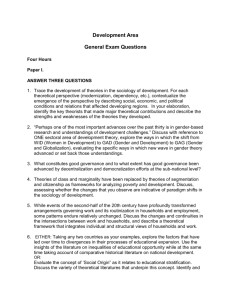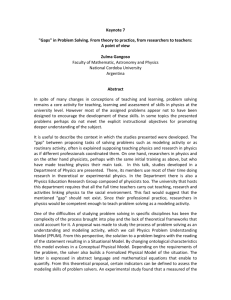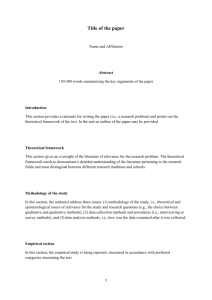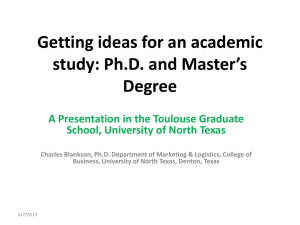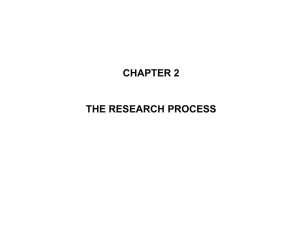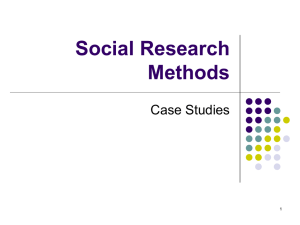Conceptual Framework
advertisement
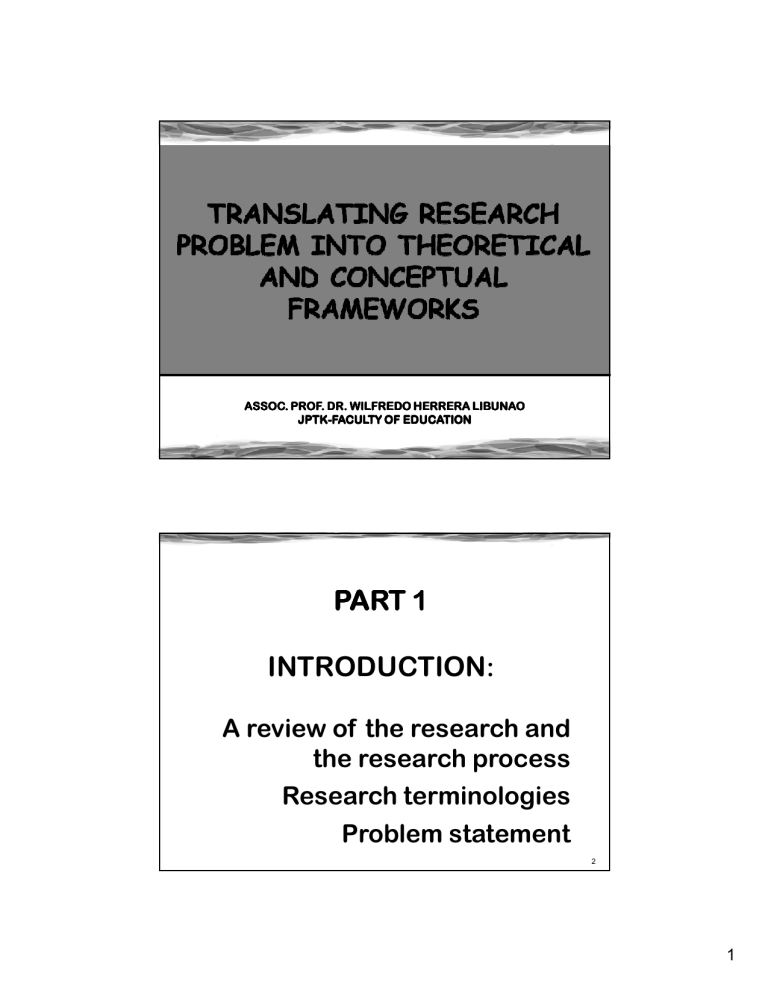
11/28/2013 ASSOC. PROF. DR. WILFREDO HERRERA LIBUNAO JPTKJPTK-FACULTY OF EDUCATION 1 PART 1 INTRODUCTION: A review of the research and the research process Research terminologies Problem statement 2 1 11/28/2013 Characteristics of a poor thesis: [In: ‘It’s a PhD, not a Nobel Prize’: how experienced examiners assess research theses, Mullins and Kelly, 2002] • • • • work that is not original; researching the wrong problem lack of understanding of the theory; mixed or confused conceptual and methodological perspectives; • not being able to explain at the end of the thesis what had actually been argued in the thesis; • lack of coherence; and • lack of confidence; 3 KEY PROSPECTUS COMPONENTS START/END Real world problem and lack of ability to solve it drives research Problem Statement The purpose drives the appropriate questions Purpose Statement Impact on the Problem Expected Outcome Question Hierarchy Research Questions Variables & Relationships Existing Research Findings Expected Contribution to Knowledge Adapted from: Latham, 2005 Predicted Answers to Research Questions Low Overall Research Approach Variable & Relationships Drawing Conclusions Meaning of findings Hypothesis Literature Review + Theoretical Framework Conceptual Framework New knowledge to help solve the Problem High Level of Empirical Knowledge Quantitative Qualitative Mixed Data Collection Plan Data Analysis Plan Findings Data for Analysis Measurement Plan Measurement Instrument(s) 4 2 11/28/2013 RESEARCH DESIGN FRAMEWORK 1. Problem 2. Purpose 3. Research Questions 1. Identify a “real world” problem 2. Describe the undesirable symptoms 3. Identify the knowledge gap that needs to be filled in order to help solve the problem 4. Support your discussion with solid peer-reviewed references Deliverable- Describe the new knowledge and insights the study will produce that will help fill the knowledge gap identified in the problem statement (not the specific content but the “type” of new knowledge) 1. Identify the “type(s)” of questions that need to be answered to fulfill the purpose 2. Develop the main research questions and sub-questions 3. Develop hypotheses as appropriate 9. Conclusions 4. Conceptual Framework 5. Lit. Review/Theoretical F’work 1. Identify the larger application(s) and meaning(s) of the findings 2. Identify how the applications contribute to the knowledge gap 3. Identify the limitations associated with the findings and conclusions 1. Identify and diagram the key variables in the research questions 2. Identify and diagram the key relationships between variables 3. Identify and diagram the key context factors 4. Describe the framework 8. Data Analysis 7. Data Collection 6. Overall Approach 1. Based on the research questions, the overall approach and data collected, identify the data analysis methods (be specific) 2. Identify the validity and reliability issues and methods to address the issues 1. Develop a measurement plan for the variables in the research questions and hypotheses (survey, interview guide, etc.) 2. Develop a data collection plan including sampling strategy and data collection process 1. Identify the “level” of empirical knowledge (see literature review) 2. Identify the type of knowledge needed (purpose statement) 3. Identify the options selected approach based on the “research arc” 4. Describe the approach 1. Create an outline or “mindmap” of the key theories and concepts 2. Dig deep into the “peer-reviewed” literature for each theory and concept and create annotated bibliography and literature map 3. Write the literature review 4. Diagram and describe the theoretical framework 5 [Adapted from: Latham, 2005] RESEARCH DESIGN FRAMEWORK 1. Problem 2. Purpose 3. Research Questions Deliverable- Describe the new knowledge and insights the study will produce that will help fill the knowledge gap identified in the problem statement (not the specific content but the “type” of new knowledge) 1. Identify the “type(s)” of questions that need to be answered to fulfill the purpose 2. Develop the main research questions and sub-questions 3. Develop hypotheses as appropriate 1.Identify a “real world” problem 2.Describe the undesirable symptoms 3.Identify the knowledge gap that 9. Conclusions 4. Conceptual Framework needs to be filled in order to help 1. Identify the larger application(s) 1. Identify and diagram the key variables in the research questions and meaning(s) of the findings solve the problem 2. Identify and diagram the key 2. Identify how the applications relationships between variables contribute to the knowledge gap 4.Support your discussion with solid 3. Identify and diagram the key 3. Identify the limitations context factors associated with the findings and peer-reviewed references 4. Describe the framework conclusions 5. Literature Review 1. Create an outline or “mindmap” of the key theories and concepts 2. Dig deep into the “peer-reviewed” literature for each theory and concept and create annotated bibliography and literature map 3. Write the literature review 4. Diagram and describe the theoretical framework 8. Data Analysis 7. Data Collection 6. Overall Approach 1. Based on the research questions, the overall approach and data collected, identify the data analysis methods (be specific) 2. Identify the validity and reliability issues and methods to address the issues 1. Develop a measurement plan for the variables in the research questions and hypotheses (survey, interview guide, etc.) 2. Develop a data collection plan including sampling strategy and data collection process 1. Identify the “level” of empirical knowledge (see literature review) 2. Identify the type of knowledge needed (purpose statement) 3. Identify the options selected approach based on the “research arc” 4. Describe the approach [Adapted from: Latham, 2005] 6 3 11/28/2013 Choosing a research topic: you need a research problem Move on to next stage of research design 1. Read literature, reflect, discuss and identify gaps 2. Generate list of interesting potential questions Yes No 6. Does a suitable problem exist? 5. Eliminate impractical questions Yes 3. Check literature. Have questions been answered already? No 4. Test feasibility Figure _.How to identify a research problem (adapted from Collis & Hussey, 2003) 7 Statement of the Problem This section should be able to answer: • Why does this research need to be conducted? • What will happen if you didn’t do this research? • What will happen as a result of this research? 8 4 11/28/2013 Statement of the Problem2cont’d This section leads to formulation of the specific research question(s). The research question/s should have several characteristics: 1. it should be phrased in the form of a question; 2. the question should suggest a relationship between variables to be examined (unless the study is exploratory or descriptive or qualitative in nature).; 3. the research question should imply the possibility of empirical testing. 9 It serves as the foundation of the entire proposal or thesis If written properly, it highlights the: Scope of the study Variables Population of interest 10 5 11/28/2013 “How do people feel?”- Too general / vague “How do employees at UTM feel about compensation, benefits, and recognition programs based on their experiences within the organization and how does this influence their level of job satisfaction in their work roles and commitment to the university and, possibly, their productivity?”- Too broad “What are the factors that contribute to employee job satisfaction at Universiti Teknologi Malaysia?”- Clear and succinct 11 “What are the factors that contribute to employee job satisfaction at UTM?” Scope of study: Components of employee job satisfaction within Universiti Teknologi Malaysia. Variables: IV = Factors contributing to employee job satisfaction DV = Job satisfaction I/MV = None anticipated Population of interest: Employees of UTM 12 6 11/28/2013 Hypothesis (if applicable) • This section is necessary only if you have a particular theory/framework/premise that you are testing. • In the case of exploratory research, for example, a hypothesis is not necessary. 13 Hypotheses: • Conjectural statements that explain relationships. • Use to test theories. • Guide research Scientific Knowledge: • Propositions supported by systematic research. Purpose of Research (Science): To test theory and to provide reliable explanation. explanation 14 7 11/28/2013 IMPORTANCE OF THEORIES Theories are constructed to give an explanation of phenomena [Stam, 2000]. Three functions of a theory [Denzin, 1970]: 1. Permitting organization of descriptions, 2. leading to explanation, and 3. furnishing the basis for prediction of future events. 15 Importance of Theories…cont’d: In a nutshell, theories: - Tell us what we are doing - Tell us why we do things - Not how to do things - It help us better understand the process - Will enable us to predict what is going to happen in the future 16 8 11/28/2013 EXAMPLE? STIMULUS--RESPONSE THEORY STIMULUS Stimulus Freedom to Choose Self- awareness Response Independent will Conscience Imagination 17 Concepts Variables Generalizations Assumptions Hypotheses Concepts Variables Empirical Testing Principles 18 9 11/28/2013 The Elephant Six blind sages were shown an elephant and met to discuss their experience. “It's wonderful,” said the first, “an elephant is like a rope: slender and flexible.” “No, no, not at all,” said the second, “an elephant is like a tree, sturdily planted on the ground.” “Nonsense,” said the third, “an elephant is like a wall.” “Incredible,” said the fourth, “an elephant is a tube filled with water.” “What a strange and piecemeal beast this is,” said the fifth. “Strange indeed,” said the sixth, “but there must be some underlying harmony. Let us investigate the matter further.” [Adapted from a traditional Hindu fable] 19 IMPORTANCE OF CONCEPT • A concept is a mental abstraction which allows generalization and the extension of knowledge from some known objects to others unknown. • A concept is formed by taking a number of similar entities and deciding what makes them similar in an important way. • Concepts are bearers of meaning, as opposed to agents of meaning. A single concept can be expressed by any number of languages. 20 10 11/28/2013 Importance of concept cont’d • In other words concepts are essentially hypotheses that will become invalid, should they fail to fit in some critical way the empirical reality it is claimed they represent. • In science its concepts drive research, steering inquiry according to the meaning of each. 21 Theory, research, and practice are in a dynamic relationship. Each set of relationships is reciprocal: theory guides practice, but practice reinforces, refines, or disconfirms theory; theory guides research, but research creates and refines theory; and research guides practice, but practice directs research. T R P 22 11 11/28/2013 RELATIONSHIP BETWEEN THEORY AND RESEARCH • Theory development relies on research and research relies on theory. • The relationship between the two is dialectic (Brown, 1977) - a transaction whereby theory determines what data are to be collected and research findings provide challenges to accepted theories. • One of the purpose of research is to generate new theory or to test an existing one. PART 2 LITERATURE REVIEW AND THE THEORETICAL/ CONCEPTUAL FRAMEWORKS ASSOC. PROF. DR. WILFREDO HERRERA LIBUNAO JPTKJPTK-FACULTY OF EDUCATION 24 12 11/28/2013 RESEARCH DESIGN FRAMEWORK 1. Problem 2. Purpose 3. Research Questions 1. Identify a “real world” problem 2. Describe the undesirable symptoms 3. Identify the knowledge gap that needs to be filled in order to help solve the problem 4. Support your discussion with solid peer-reviewed references Deliverable- Describe the new knowledge and insights the study will produce that will help fill the knowledge gap identified in the problem statement (not the specific content but the “type” of new knowledge) 1. Identify the “type(s)” of questions that need to be answered to fulfill the purpose 2. Develop the main research questions and sub-questions 3. Develop hypotheses as appropriate 9. Conclusions 4. Conceptual Framework 1. Identify the larger application(s) and meaning(s) of the findings 2. Identify how the applications contribute to the knowledge gap 3. Identify the limitations associated with the findings and conclusions 1. Identify and diagram the key variables in the research questions 2. Identify and diagram the key relationships between variables 3. Identify and diagram the key context factors 4. Describe the framework 8. Data Analysis 1. Based on the research questions, the overall approach and data collected, identify the data analysis methods (be specific) 2. Identify the validity and reliability issues and methods to address the issues 5. Literature Review/Theoretical Framework 1.Create an outline or “mindmap” of the key theories and concepts 2.Dig deep into the “peer-reviewed” literature for each theory and concept and create annotated bibliography and literature map 6. Overall Approach 7. Data Collection 3.Write the literature review 1. Identify the “level” of empirical 1. Develop a measurement plan for 4.Diagram and describe knowledgethe (see literature review) the variables in the research 2. Identify the type of knowledge questions and hypotheses theoretical framework needed (purpose statement) (survey, interview guide, etc.) 2. Develop a data collection plan including sampling strategy and data collection process 3. Identify the options selected approach based on the “research arc” 4. Describe the approach [Adapted from: Latham, 2005] 25 The Relationship Between the Literature Survey and the Theoretical Framework • The literature review provides a solid foundation for developing the theoretical framework. • The literature review identifies the variables that might be important, as determined by previous research findings. 26 13 11/28/2013 Theoretical Framework • This is the “creative” section of your work, where you define your research’s theoretical frame. • It is different from the literature review, in that here you discuss your own original integration of the major theories and/or frameworks that you intend to apply, which serves as the basis of the conceptual definitions of your variables and the laws of interactions or presumed relationships among them. • The build-up of arguments from the literature review, to the theoretical and conceptual frameworks, to the research problem and hypothesis should be clear and logical. 27 Theoretical Framework The theoretical framework of the study is a structure that can hold or support a theory of a research work. It presents the theory which explains why the problem under study exists. Thus, the theoretical framework is but a theory that serves as a basis for conducting research. 28 14 11/28/2013 HOW SHOULD THE THEORETICAL FRAMEWORK be FORMULATED? 1. specify the theory/ies you will use as basis for the study 2. mention the proponents of the theory 3. cite the main points emphasized in the theory 4. support your exposition of the theory by ideas from other experts; 5. illustrate your theoretical framework by means of a diagram; and, 6. reiterate your theoretical proposition in the study. 29 Conceptual Framework After formulating the theoretical framework, the researcher has to develop the conceptual framework of the study. While the theoretical framework is the theory on which the study is based, the conceptual framework is the operationalization of the theory. 30 15 11/28/2013 PART 3 ASSOC. PROF. DR. WILFREDO HERRERA LIBUNAO JPTKJPTK-FACULTY OF EDUCATION 31 RELATIONSHIP BETWEEN THEORETICAL AND CONCEPTUAL FRAMEWORKS • Conceptual framework come from: - theories with well-organised principles and propositions that have been confirmed by observations, research or experiments; - models derived from theories, observations or sets of concepts, or - evidence-based best practices derived from outcome and effectiveness studies. 32 16 11/28/2013 RESEARCH DESIGN FRAMEWORK 1. Problem 2. Purpose 3. Research Questions 1. Identify a “real world” problem 2. Describe the undesirable symptoms 3. Identify the knowledge gap that needs to be filled in order to help solve the problem 4. Support your discussion with solid peer-reviewed references Deliverable- Describe the new knowledge and insights the study will produce that will help fill the knowledge gap identified in the problem statement (not the specific content but the “type” of new knowledge) 1. Identify the “type(s)” of questions that need to be answered to fulfill the purpose 2. Develop the main research questions and sub-questions 3. Develop hypotheses as appropriate 4. Conceptual Framework 1.Identify and diagram the key 5. Literature Review variables in the research questions1. Create an outline or “mindmap” of the 1. Identify the larger application(s) key theories and concepts and meaning(s) of the findings 2.Identify and diagram the key 2. Dig deep into the “peer-reviewed” 2. Identify how the applications literature for each theory and concept contribute to the knowledge gap create annotated bibliography relationships between variables and 3. Identify the limitations and literature map associated with the findings and 3. Write the literature review 3.Identify and diagram the key conclusions 4. Diagram and describe the theoretical framework context factors 4.Describe7.the framework 8. Data Analysis 6. Overall Approach Data Collection 9. Conclusions 1. Based on the research questions, the overall approach and data collected, identify the data analysis methods (be specific) 2. Identify the validity and reliability issues and methods to address the issues 1. Develop a measurement plan for the variables in the research questions and hypotheses (survey, interview guide, etc.) 2. Develop a data collection plan including sampling strategy and data collection process 1. Identify the “level” of empirical knowledge (see literature review) 2. Identify the type of knowledge needed (purpose statement) 3. Identify the options selected approach based on the “research arc” 4. Describe the approach 33 [Adapted from: Latham, 2005] Conceptual frameworks Often draw on: • One or more theories • Empirical evidence • Knowledge specific to the particular case Serve to: • Summarize and integrate knowledge • Provide explanations for causal linkages • Generate hypotheses 34 17 11/28/2013 Building a conceptual framework • Start with the endpoint (dependent variable, outcome, or target point for intervention) • Identify potential correlates, based on empirical or theoretical evidence • Show antecedent , intervening or mediating variables by proximity to dependent variables 35 Conventions for drawing a conceptual framework 1. Only include concepts that will be operationally defined and measured 2. Present left-to-right or top-to-bottom 3. Use arrows to imply causality 4. Label concepts succinctly 5. Do not include operational definitions or values of variables in the framework 36 18 11/28/2013 Types of Variables Researchers usually begin with an effect, then search for its causes while focusing on the relationship between two things in which one causes other. Variables are classified depending on their location in a causal relationship. • Independent Variable The cause variable, or the one that identifies forces or conditions that act on something else, is the independent variable. • Dependent Variable The variable that is the effect or is the result or outcome of another variable is the dependent variable. 37 Types of Variables…cont’d • Intervening Variable A basic causal relationship requires only an independent and a dependent variable. A third type of variable, the intervening variable, appears in more complex causal relations. It comes between the independent and dependent variable and shows the link or mechanism between them. • Moderator Variable Affect the relationship between the independent and dependent variables by modifying the effect of the intervening variable(s). Typical moderator variables social research (when they are not the major focus of the study) include the sex, age, culture, or language proficiency of the subjects. 38 19 11/28/2013 Independent Dependent Cause Predictor Stimulus Manipulated treatment The Independent variable is presumed to have an effect on or cause change in the dependent variable Consequence Outcome Effect Intervening Moderating Mediating The Dependent variable is influenced by changes in the IV These variables are presumed to explain or influence the link between the IV and DV. 39 Exercise 1 People who have had formal debate training will report higher levels of aggressiveness than will people who have not had debate training. Answer: IV: Debate training DV: Level of aggressiveness 40 20 11/28/2013 Exercise 2 College educated individuals who have high levels of exposure to television news will report greater satisfaction with life than college-educated individuals who have low levels of exposure to television news. 41 Exposure to TV news Independent variable Satisfaction with life Dependent variable Constant: College education 42 21 11/28/2013 It has been found that there is a relationship between the availability of Reference Manuals that manufacturing employees have access to, and the product rejects. That is, when workers follow the procedures laid down in the manual, they are able to manufacture products that are flawless. 43 Answer to the Example 3 Availability of reference manual Independent variable Number of rejects Dependent variable 44 22 11/28/2013 Although this relationship is true in general for all workers, but it is not true for workers who are not using the manual every time they need it. Thus, the interest and inclination of the workers is a Moderating Variable. 45 Answer to the Example 3 Availability of reference manual Independent variable Number of rejects Interest and inclination Dependent variable Moderating variable 46 23 11/28/2013 A prevalent theory is that the diversity of the workforce (according to different ethnic origins, races, and nationalities) contributes more to organizational effectiveness because each group brings its own special expertise and skills to the workplace. This synergy can be exploited, however, only if managers know how to harness the special talents of the diverse work group; otherwise, they will remain untapped. 47 Answer to Exercise 4 Workforce diversity Independent variable Organizational effectiveness Managerial expertise Dependent variable Moderating variable 48 24 11/28/2013 GROUP WORK 49 MECHANICS 1. Divide the class into several groups with 7-10 members. 2. Each group to assign a facilitator and a spokesperson. 3. Each group to review the two examples on how to translate problem statement into theoretical and conceptual frameworks. 4. Critique the two materials using the knowledge gained in this colloquium. 5. Share your critique results in the plenary Group discussion and analysis: Sharing: 5 min per group 15 minutes 50 25 11/28/2013 Evaluating a Framework • Is framework clearly identified? • Is framework appropriate for the topic? • Are concepts and variables clearly and appropriately defined? • Is basis for the hypothesis(es) clear and consistent? 51 ELEMENTS OF RESEARCH Theoretical Framework Conceptual Framework ……………………………………………… Methodology Plan of action, research design and why Methods Techniques •Surveys •Interviews •observation 52 26 11/28/2013 RESEARCH ARC- CHOOSING THE OVERALL RESEARCH APPPROACH 2. Quantitative survey to enhance the case study 1. Qualitative case study Mixed Models are Quantified Models are Analyzed and Weighed Models are Developed Flexible Fixed QuasiDeductive Models are Tested Questions Emerge Qualitative Theory Building Theory Testing Inductive Vague Notion Quantitative Deductive Where is the topic on the research arc? Level of Empirical Knowledge 53 PARTING WORDS The theoretical or conceptual grounding of a study is designed to help the researcher-- not boggle his/her mind. It is undertaken not simply for the advantage of the reader of a proposal, but for the researcher as a conceptual map to the investigation. 54 27 11/28/2013 END OF SESSION 55 28
